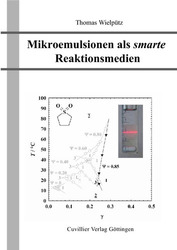| Areas | |
|---|---|
| Serie de libros (96) |
1378
|
| Nachhaltigkeit |
3
|
| Gesundheitswesen |
1
|
| Letra |
2362
|
| Ciencias Naturales |
5406
|
| Matemática | 229 |
| Informática | 319 |
| Física | 980 |
| Química | 1363 |
| Geociencias | 131 |
| Medicina humana | 243 |
| Estomatología | 10 |
| Veterinaria | 108 |
| Farmacia | 147 |
| Biología | 835 |
| Bioquímica, biología molecular, tecnología genética | 121 |
| Biofísica | 25 |
| Nutrición | 45 |
| Agricultura | 1004 |
| Silvicultura | 201 |
| Horticultura | 20 |
| Ecología y conservación de la tierra | 148 |
| Ciencias Ingeniería |
1790
|
| General |
97
|
|
Leitlinien Unfallchirurgie
5. Auflage bestellen |
|
Erweiterte Suche
Mikroemulsionen als smarte Reaktionsmedien (Tienda española)
Thomas Wielpütz (Autor)Previo
Indice, Datei (41 KB)
Lectura de prueba, Datei (180 KB)
Abstract
Recently, the application of microemulsions as smart media for organic and inorganic syntheses has received considerable attention.
Water swollen micelles can be regarded as nano-sized reaction vessels for the synthesis of metal nanoparticles. However, the effect of the micelles’ exchange kinetics on the shape and size of the particles has not yet been clarified.
Therefore, I investigated the micelles’ exchange kinetics for the non-ionic surfactant based system H2O – n-alkane – CiEj (n-alkyl polyoxyethylene). The rate constant of the exchange does not depend on the size of the micelles and weakly on their concentration.
In efficient microemulsion systems, the exchange kinetics are slowed down considerably.
Microemulsion systems are not yet optimized as potential reaction media for highly reactive reagents.
Thus, the most reactive component, namely water, was replaced by the inert tetrahydrothiophen-1,1-dioxide (sulfolane).
By chosing the long chained surfactants C18E6 and C18E8 as amphiphiles, I was the first to formulate a water-free microemulsion system containing sulfolane – n-octane – C18E6/C18E8.
At first, inorganic synthesis of platinum, bismuth and lead nanoparticles was conducted in inexpensive ionic surfactant based microemulsion systems of the type H2O/salts – oil – ionic surfactant – cosurfactant. Moreover, bicontineous microemulsions comprising H2O – oil – nonionic surfactant – cosurfactant were effectively used to overcome reagent incompatibilities for the epoxidation of D,E-unsaturated enones.
The reaction in the microemulsion systems was up to 35 times faster than in heterogeneous two-phase systems.
Kurzzusammenfassung
Die Nutzung von Mikroemulsionen als smarte Reaktionsmedien für die organische und anorganische Synthese erhielt in den letzten Jahren immer mehr Aufmerksamkeit.
So werden nanoskalige Wasser geschwollene Mizellen als Template für die Synthese von Nanopartikeln verwendet.
Der Einfluss der temporären Koaleszenz dieser geschwollenen Mizellen auf die Form und Größe der Nanopartikel ist noch nicht geklärt. Diese Arbeit untersucht zunächst die Koaleszenzkinetik Wasser geschwollener Mizellen des Typs H2O –n-Alkan – n-Alkylpolyglycolether (CiEj). Die Austauschkinetik hängt nicht von der Größe der Tröpfchen und kaum von deren Konzentration ab. Effizientere Mikroemulsionssysteme verzögern dabei die Austauschkinetik beträchtlich.
Um inerte Mikroemulsionen zu formulieren, wurde die reaktivste Komponente, das Wasser, gegen das inerte Tetrahydrothiophen-1,1-dioxid (Sulfolan) ausgetauscht.
Durch die Verwendung sehr langkettiger Tenside konnte erstmals eine Mikroemulsion aus Sulfolan – n-Oktan – C18E6/C18E8 dargestellt werden.
Zunächst wurden jedoch Platin, Blei und Bismut Nanopartikel aus preiswerten Wassertröpfchen in Öl Mikroemulsionen des Typs H2O – n-Alkan – ionisches Tensid – Cotensid synthetisiert.
Neben diesen eher als anorganisch aufzufassenden Reaktionen wurden bikontinuierliche Mikroemulsionen des Typs H2O – Öl – nichtionisches Tensid – Cotensid als Reaktionsmedium zur Epoxidierung von D,E-ungesättigten Enonen verwendet.
Dabei konnten erfolgreich Reaktand-Inkompatibilitäten überwunden und bis zu 35-fache Reaktionsbeschleunigungen erreicht werden.
| ISBN-10 (Impresion) | 3865379648 |
| ISBN-13 (Impresion) | 9783865379641 |
| ISBN-13 (E-Book) | 9783736919648 |
| Idioma | Alemán |
| Numero de paginas | 202 |
| Edicion | 1 |
| Volumen | 0 |
| Lugar de publicacion | Göttingen |
| Lugar de la disertacion | Köln |
| Fecha de publicacion | 30.07.2006 |
| Clasificacion simple | Tesis doctoral |
| Area |
Química
|








